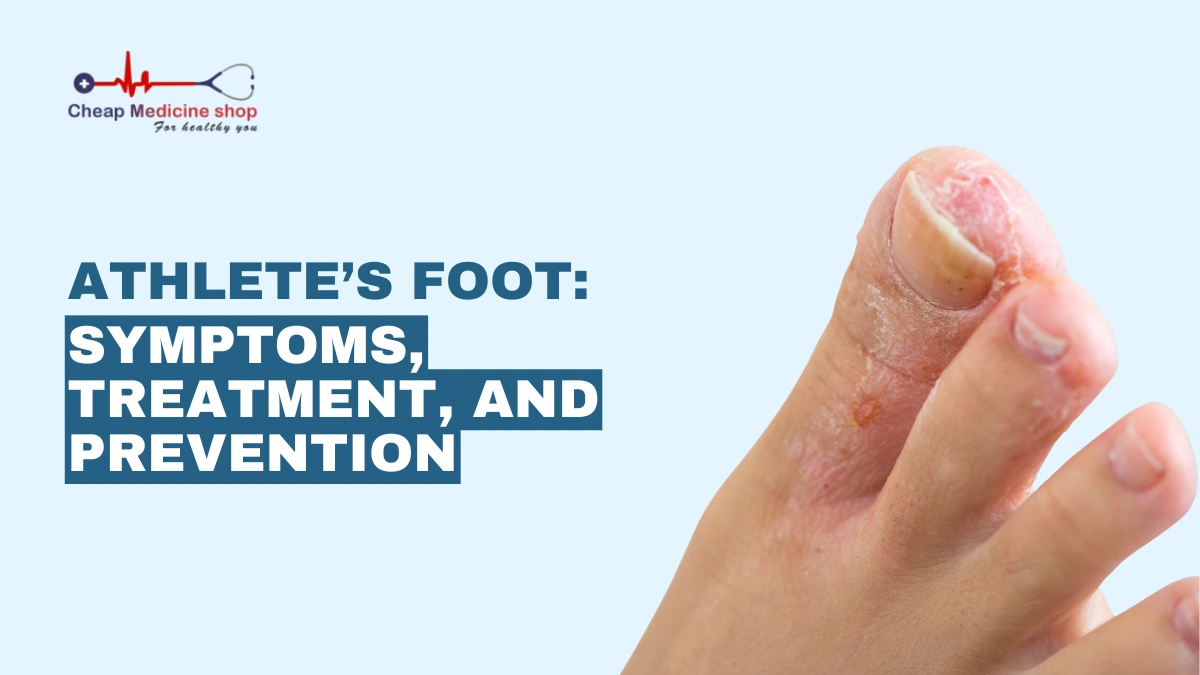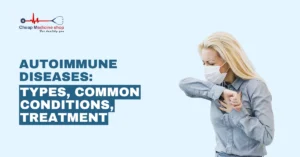Fungal infections of the feet are among the most common skin conditions worldwide. They often develop in warm, moist environments that encourage fungal growth. One of the most widespread types is Athlete’s Foot, also known as Tinea Pedis. It affects up to 15-25% of people globally at any given time.
This condition affects one or both feet and causes itching, redness, peeling, or a burning sensation, especially between the toes or on the soles. While many mild cases respond well to Over-the-counter (OTC) treatments, untreated infections can lead to complications like cracked skin, secondary bacterial infections, or even toenail fungus.
Recognizing the early signs and understanding how to manage and prevent infection is key to keeping your feet healthy. This article covers causes, diagnosis, treatments, and tips for prevention so you can confidently treat Athlete’s Foot and protect your feet.
What is Athlete’s Foot?
Athlete’s Foot is a type of ringworm infection on the feet. It is commonly misinterpreted as a fungal disease, but it is an infection that spreads through direct contact with infected skin or contaminated surfaces.
It can take various forms depending on which areas of the foot are affected. The types of Athlete’s Foot include:
- Interdigital type: This is the most common form, typically developing between the toes, especially between the fourth and fifth toes. Symptoms include peeling skin, redness, itching, and sometimes a burning sensation. Moisture and tight shoes often worsen this type.
- Moccasin type: This form affects the soles, heels, and sides of the foot, resembling a moccasin (affected area resembles the shape of a moccasin or soft shoe) pattern. It usually causes dry, thickened, and scaly skin. Cracking and chronic dryness may also occur, making it appear similar to Eczema.
- Vesicular type: It is characterized by sudden outbreaks of fluid-filled blisters, usually on the bottom or sides of the foot. These blisters may be itchy or painful and are often triggered by stress, allergic reactions, or moisture buildup.
- Ulcerative type: This is a more severe and rare form, characterized by painful open sores or ulcers located between the toes or on the sole. It typically requires prompt medical treatment.
Save up to 90% on your medicine bills

Candid Cream 15 gm

Sebifin Cream 1% (10gm)

Terbest Cream

Canesten Dusting Powder
What are its symptoms?
Athlete’s Foot symptoms may vary, but some are common to nearly all cases, such as:
- Itching or burning on the soles or between the toes
- Red, flaky, peeling, or cracked skin
- White, soggy patches in moist areas
- Blisters or sores
- Dry or scaly skin on the sides or bottom of the foot
- Unpleasant odor
- Thick, crumbly toenails if the infection spreads
What causes Athlete’s foot?
Athlete’s Foot develops when certain fungi, mostly dermatophytes, grow unchecked on the skin. The most common ones are Trichophyton rubrum, Epidermophyton floccosum, and Trichophyton mentagrophytes. These fungi thrive in warm, damp environments.
Since this fungal infection is contagious, it spreads easily in showers, pools, or through contact with contaminated towels, shoes, or floors. If you touch your feet with contaminated hands, you can spread the fungus to other parts of your body.
Scratching or skin damage from the infection can also lead to secondary bacterial infections. Some examples include Impetigo (honey-colored, crusted lesions), Abscesses (pockets of pus under the skin) and Green Nail Syndrome.
Diagnosis and tests
A doctor usually diagnoses the Athlete’s Foot by physically examining the affected skin. In some cases, further tests may be used. Some of them include:
- Scraping a small skin sample for examination under a microscope or lab culture.
- Review of recent activities and exposure to communal areas.
- Differential diagnosis to rule out skin conditions, such as Eczema or Psoriasis.
Treatment and management
Generally, non-prescription products and home care effectively treat Athlete’s foot. Options usually include topical antifungal creams, gels, powders, lotions, and sprays.
Over-the-counter (OTC) products containing Terbinafine, Clotrimazole, Miconazole, or Tolnaftate are effective for mild cases. These are usually applied for 2-4 weeks, even if symptoms improve early. It is best to consult a doctor to determine the ideal treatment option, dosage, and duration.
You can also try a home remedy for Athlete’s Foot, such as soaking feet in saltwater, vinegar, or tea tree oil solution, which may provide mild relief alongside treatment. Severe or persistent cases may require oral antifungals, such as Itraconazole or Fluconazole, prescribed by a physician.
How to prevent it?
Simple steps can curb Athlete’s Foot and stop it from coming back:
- Wash your feet daily, especially between the toes, and dry thoroughly.
- Wear sandals or waterproof shoes in gyms, pools, showers, and public changing rooms.
- Change your socks once or twice a day, preferably using cotton or moisture-wicking materials.
- Rotate shoes and allow time for each pair to dry out.
- Avoid sharing towels, socks, or shoes.
- Use antifungal powders if you are prone to recurrent infections.
- Keep toenails trimmed and shoes clean.
When to see a doctor?
While most cases of Athlete’s Foot can be managed at home with Over-the-counter (OTC) creams and proper hygiene, you should consult a doctor if:
- The infection does not improve after 2-4 weeks of OTC treatment.
- Symptoms worsen, spread to other parts of the body, or involve the toenails.
- You notice severe pain, swelling, pus, or foul odor, which may indicate a secondary bacterial infection.
- You have a weakened immune system, poor circulation, or Diabetes, which can increase the risk of complications.
- There are recurring infections, suggesting an underlying health or hygiene issue.
Timely medical assistance can prevent further complications and help select stronger prescription antifungals if necessary.
Conclusion
Athlete’s Foot is a common but very treatable skin fungal infection. Its symptoms include itching, burning, and cracked skin. Most cases improve quickly with topical antifungal creams, such as Terbinafine and Clotrimazole. Soaking feet in saltwater or vinegar is also an effective home remedy.
However, you should always seek medical advice for Athlete’s Foot treatment if symptoms persist or the infection spreads to the nails. For severe infections, a doctor may prescribe oral antifungals such as Itraconazole or Fluconazole.
To prevent future instances, maintaining good foot hygiene, wearing sandals or breathable footwear, changing socks daily, and avoiding the sharing of clothes and towels are recommended. With effective management, you can protect your health and reduce the spread of fungus in your home and surroundings.
Frequently Asked Questions
How long does it take for hydrogen peroxide to kill Athlete’s Foot?
Hydrogen peroxide is not recommended for treating fungal infections. It is neither a first-line treatment nor very effective, and it can also slow down the wound healing process.
Will Athlete’s Foot go away?
No, it will not go away on its own. You need to use home remedies and practice proper hygiene. An untreated or worsening infection can spread to other body parts. In such cases, medical treatment is essential.
What are the stages of an Athlete’s Foot?
The early stage of infection includes mild itching, redness, and peeling between the toes. Then, it may spread to the soles and sides, causing dry, scaly, or cracked skin. In the severe stage, blisters, sores, or nail involvement can occur, requiring medical treatment.
Do I need to throw away shoes after Athlete’s Foot?
No, you do not need to throw away your shoes after the infection. However, you do need to disinfect them. Use antifungal sprays or wipes to clean them. You can also use home remedies, such as a solution of white vinegar. Wait for your shoes to dry after disinfecting before you wear them.
Should I wear socks to bed with an Athlete’s Foot?
Yes, you should wear socks to bed. They help prevent the spread of infection to other body parts or avoid contaminating sheets. They also keep your feet dry and prevent further fungal growth.
Is Athlete’s Foot genetic?
Yes, it can be genetic. Some individuals are more likely to be infected due to a family history of Eczema, allergies, or sweaty feet. If your close family members have this fungal infection, taking preventive measures to minimize the risk is advised.
Cheap Medicine Shop only refers to credible, authoritative sources for our content. If you’re curious about how we ensure the integrity of our content, we encourage you to read our Content Information Policy.














